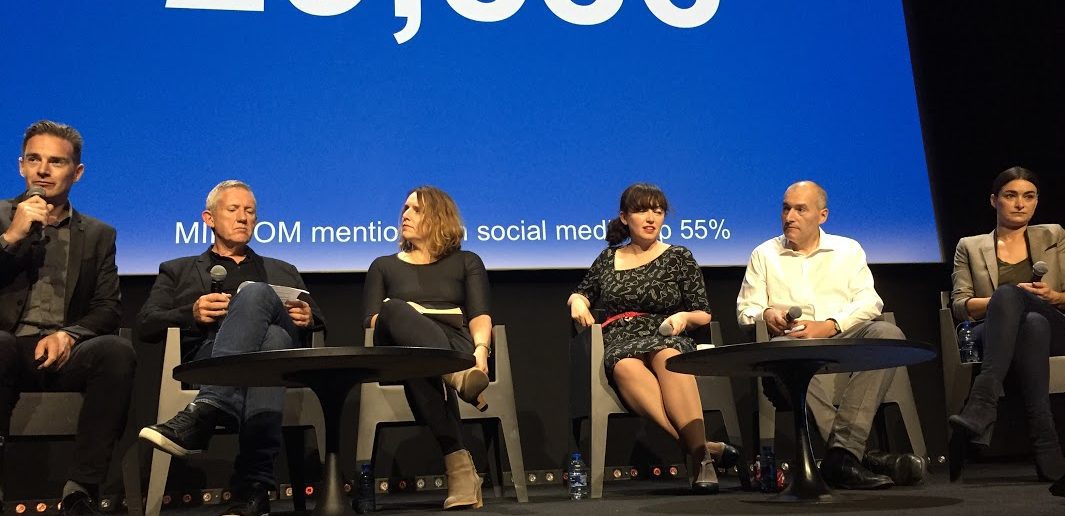MIP Markets head of social media James Martin hosted this week’s trending topics session, featuring MIP Publications editor in chief Julian Newby, Sandrine Pechels de Saint Sardos, director of disruption and platform distribution at TFO; Black Meteor founder and content consultant Lisa Gray; research director Guy Bisson of Ampere Analysis; and journalist Marjorie Paillon of France 24, who is also the founder of I Love Production.
The term MIPCOM saw 29,536 mentions on social media, up 55% from last year, Martin said. The panel kicked off with a review of keywords that were associated with MIPCOM, and the most popular hashtags of the week. But just to get it out of the way, they kicked off by discussing the elephant in the room (and the word cloud): Harvey Weinstein.
“Every film is a small business in itself,” Newby said. “When you’re an actor or actress working on a film, it’s technically your last film. you never know if you’ll ever do another.” This dynamic brings out monsters in people.
“We should distinguish that from TV,” he went on. “In our industry there are lots of powerful women; it’s not like that in Hollywood, it’s very neanderthal, an environment that allows this stuff to happen.” He admonished viewers, “Don’t punish the entertainment industry for this. This is everywhere. Powerful white men must think again about how they behave.”
“It’s a wakeup call for women, to be together and help each other more than ever,” de Saint Sardos said.
For Gray, the biggest good to come out of the Weinstein drama was discussion. “Everyone’s talking about it,” she observed, which will perhaps destigmatise the act of reporting on a compromising situation. “That’s what’s been really good about the intense conversations going on in last week.”
Other popular hashtags this week included #eoneTV — which, thanks to activities with stars and efficient promotions on social, was cited in a whopping 10 percent of tweets — the British show #SuperMarketSweep; #MIPJunior, thanks to upset around train female characters who will replace two male ones in the upcoming Thomas & Friends; #skam and #facebookwatch—both of which refer to Facebook’s show platform. (Skam is a Norwegian show that will be launched there soon.)
Last of all the chart-toppers were #europeanfilmforum and #britannia.
We also talked a great deal about diversity. Notably, this was the first year Diversify TV held its Excellence Awards, with support from A+E Networks, EbonyLife TV and Viacom. Lenny Henry also talked about tax breaks for diversity in a much-discussed keynote.
“The more opportunity we give different faces onscreen, the better. It encourages creativity and connects us all,” said Gray. “We have tax breaks for things in Australian production that have really helped—like the Vampire Initiative with A&E—and I’m a big fan of more diversity because of the creativity that comes out.”
Newby referred to something that happened during Henry’s panel: White, able-bodied men were asked by the moderator to stand up and look around them. (They were then later asked to go over to the nearest minority, take a selfie and tweet it.)
“It made white men the minority,” Newby said. “If you’re told to stand up and think about what you are, it’s important.”
“Diversity’s not just one thing,” de Saint Sardos said. “For the first time, we’re producing an animated preschool show where one character has no gender… I’m happy for women as producers, content providers, talent, but we need diversity on all levels—for kids as well, so all people are represented.”
“Change must happen with storytellers and producers, as well as faces we see,” Gray emphasised.
“It’s not going to change if you don’t push for it,” said Paillon. “We have to do it. If a diversity quota is imposed on French companies’ boards of directors, how many people will really go for the 40%, and how many will prefer to pay the fine?”
Next, we moved onto the topics each panelist chose as their theme for this week.
For Newby, the theme was Britannia, and drama in general. He began by telling us it’s his 28th MIP.
“Drama is an important subject at these markets,” he said. “When I first started coming to these events, the dramas for sale were American or South American—so telenovelas or white men dramas. That was pretty much it.”
In contrast, “Look at this MIPCOM,” he marveled. “It’s incredible. it’s turned on its head.” He pointed to the screening of NHK’s Kurara: The Dazzling Life of Hokusai’s Daughter, the first-ever Asian and first 4K screening in MIP history. “10 years ago people would have walked out” because it would have seemed too “different,” he said. “Today, they’re mesmerised.”
Paillon pointed to how diversity can improve our experience of drama, because it adds critical cultural nuance. “Netflix went from 7 different languages on its platform to 27,” she said. “Now it has 75 language assets”—some highly granular, like Parisian French and Quebecois French. “It makes a difference when actually trying to enjoy original content.”
Next, de Saint Sardos raised her topic: Immersive kids content.
“I was checking the 30 most-watched screenlist yesterday,” she said. “Most are amazing, but it’s really all about brand. Educational content’s becoming big, disruptive, because we have a lot of tools available.”
Some of those tools are still in deep experimental phase. She pointed out it’s difficult to use VR for kids before the age of 12 or 13, because of cerebral concerns, but “then you have AR (augmented reality), where possibilities are endless. There’s lots of freedom for kids; now they have the tools to put their imagination onto the screen.”
“(Microsoft AR headset) Hololens is exciting to watch,” Gray added. “It’s going to bring more context to everyday situations—learning, immersion.”
“Entertainment is typically passive; VR and AR need supervision,” Newby observed. What does that supervision element do to the commercial property?” He clarified: “Supervision is a disruptor in itself when trying to entertain people.” You can’t just pop a headset on your toddler and walk off to do the laundry.
De Saint Sardos implied that this supervision is an immersive feature, not a bug. For AR experiences, “it’s parents gathering kids to do an activity together,” she said. “In education, you can really explain things.”
Asked by an audience member whether kids’ perspectives are taken into account in TFO’s production process, de Saint Sardos replied, “We listen closely. If we give kids the right tools, they can be producers. that’s what we’re doing now. They can tell us a story.”
As a corollary to this, “In Canada or the US, kids have their first smartphone around age 6 or 7,” de Saint Sardos said later. Something to think about!
Gray’s trending topic of the week was mobile video.
“I’ve been lucky enough to work with lots of teenagers in the last year, and I see how much video they’re consuming on their phones,” she said, pointing to a Snapchat session in which the platform outlined its plans for better integrating with the TV industry, calling itself “a great complement to television.”
Gray is especially excited about how Snapchat is using its learnings to work with NBC in the production of scripted shows. “They’re going to make something and engage top writers,” she said. Interestingly, “Content won’t be on and available the whole time; it’s gonna disappear after awhile, which brings to mind that old style of programming”—where you had to catch something the programming window, or try recording it, to watch it.
“When Snapchat talks about condensing stories, using split-screen, it’s a fascinating development in storytelling,” Bisson added.
“I hope technologists, creators and filmmakers keep talking and have a development process to integrate the learnings they’re getting,” Gray said.
Paillon noted that all platforms—like Snapchat and Facebook—are just a hair away from becoming producers. Once that happens, you’re subject to a lot more responsibility than when you’re just a hosting platform. In the Facebook Watch session, which she moderated, she notably asked the team what their plan for responsible news reporting was; they merely replied, “It is a platform,” implying there is little they can do about how actual creators choose to use it.
Bisson’s topic was telcos as new producers.
“There’s a noticeable presence in this market of major new producers who are telcos or telco-backed”—like Liberty Global’s Platform 1, or Telefonica’s Movistar+, he said.
“When I think back to my first MIPCOM in the late ’90s, there was a similar influx of new players at that time—dot com. It was new buyers, pushing for new biz models. That did not end well. but I think this is very different. We’re talking about large, well-financed companies.”
At that time, the buzzword was “vertical integration”, where mega mergers were occurring between big studios and big infrastructure. Bisson believes this new wave is diffferent: “Big telcos and infrastructure owners have decided to invest themselves, developing studios, distribution entities, new distribution opportunities. I think that’s an exciting new trend.”
Telefonica, he noted, investing $70 million to make 6 dramas. Next year, and every year moving forward, it will be 10 dramas. Deutsch Telekom has committed to 6 or 7 dramas a year.
“It’s about differentiation in a competitive TV market. These sectors are in decline,” Bisson said. “TV is the holy grail for them; it’s one of the few businesses where average revenue per customer goes up yearly, not down. Netflix has shown you need the competitive distinction production gives you, and it’s cost effective when you have a pan-country footprint.”
Last but not least, Paillon shared her theme: Blurred lines. (Not the song. But it’s in your head now, isn’t it?)
Paillon positioned her theme as a kind of blanket takeaway for everything previously discussed. “Brands, more and more, are creating creative studios. They want to be able to manage their own storytelling and content,” she said.
“At the same time, content creators are left in the middle, not knowing what to do. It’s all about content is king, maybe storytelling is more emperor, and platforms are also queen when it comes to putting those trends, content and money together. Every line is blurred between business, industries and the creation process itself.”
We’ve been in this state of disruption for awhile, and the blurring hasn’t ceased; Snapchat and Facebook’s forays into windowing, and telcos’ attemps to produce, are only the easiest examples to mention.
There are practical reasons for wanting to have lots of creative IP, whatever business you’re in: “When you actually own the content, you can do everything. But you have to link to regulation, financing and data—the audience,” Paillon cautioned. “Once you have data, you can focus more coldly and see who your audience actually is.”
But by and large, it can be tough working in a market where a person’s role and relevance to you may change based on what you pitch them. “It’s confusing; you don’t know anymore who anyone is,” Paillon said. “You have to be a content chameleon. But follow two things: Money and data.”
She concluded, “We’re at a time when every single line of this business is blurred. Make the most of it.”




